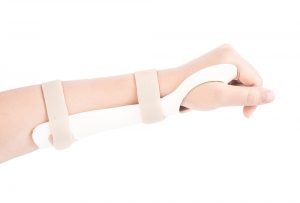
What is it?
Carpal tunnel syndrome or median nerve compression is a painful condition of the hand characterized by pain, numbness, tingling and weakness due to compression of the median nerve.
This nerve along with several tendons run from your forearm and passing into your hand through a small space in your wrist called the carpal tunnel. The median nerve controls movement and feeling of your thumb and the first three fingers, excluding the thumb.
What causes it?
Carpal tunnel syndrome is caused by pressure on the median nerve. This pressure can come from swelling anything that makes that carpal tunnel smaller:
-
Hypothyroidism
-
Rheumatoid arthritis
-
Diabetes
-
Overactive pituitary
-
Fluid retention during pregnancy
-
Menopause
-
Cyst or tumor
-
Sprain
-
Fracture
Or by overuse:
-
Hammering
-
Using a screw driver
-
Typing
-
Writing
-
Pipetting
-
Gripping activities
-
Vibrating hand tools
Symptoms
Gradual feelings of burning, tingling or “itching numbness” in the palm of the hand or fingers, especially the thumb, index and middle fingers. There is a feeling that the fingers are “swollen and useless.” The symptoms often appear at night since sleeping with flexed wrists is a common position. Shaking out the hand or wrist may make the hand feel better. Decreased grip strength becomes apparent which make it difficult to form a fist or grasp small objects. Increased incidence of dropping plates and/or glasses, inability to button or unbutton shirts are common complaints as well.
In chronic and/or untreated cases, the muscles at the base of the thumb may waste away. People may complain that they are unable to differentiate between hot and cold.
Who gets it?
Women are 3x more likely than men to develop carpal tunnel syndrome (CTS). Why? Perhaps because the tunnel itself is smaller in women than men.
The dominant hand is usually affected first and produces the most severe pain and usually only affects adults.
How is CTS diagnosed?
There are several ways that carpal tunnel can be diagnosed:
-
By medical history and physical examination of the hands arms, shoulders and neck. The wrist is especially examined for tenderness, swelling, warmth and discoloration;
-
Laboratory tests to determine whether diabetes is a factor; xrays to determine whether arthritis or fracture is present;
-
Tests that are performed by orthopedists and/or physical therapists to elicit symptoms related to CTS:
-
The Tinel test: the examiner taps on or presses on the median nerve. If tingling occurs in the affected fingers, the test is positive.
-
The Phalen’s maneuver: the person presses the backs of the hands together with their wrists flexed as much as possible. If tingling or numbness occurs in the affected fingers within 1-2 minutes, the test is positive.
-
A nerve conduction test may be performed. The study measures electrical activity of the nerves and muscles by assessing the nerve’s ability to send a signal along the nerve to the muscle. Specifically, electromyography is a special recording technique that detects electrical activity of muscle fibers and can determine the severity of damage to the median nerve.
-
Ultrasound imaging can show abnormal size of the median nerve.
How do you treat it?
If you have symptoms that you suspect are related to carpal tunnel syndrome, get treated as soon as possible. The sooner it’s treated the better the prognosis. Here are possible treatment options depending on the severity of symptoms:
Non-surgical

-
Splinting in the very early stages to keep the wrist in a neutral position;
-
Avoid daytime activities that provoke pain-take frequent rest breaks, vary tasks;
-
OTC NSAIDs can help to relieve the symptoms but have not been shown to resolve CTS;
-
Corticosteroids in the form of Prednisone (taken orally) or Lidocaine (which can be injected directly into the wrist) can relieve pressure on the median nerve for people with intermittent and/or mild symptoms. A caution: those with diabetes or are predisposed to diabetes-prolonged use of corticosteroids make it difficult to regulate insulin levels;
-
Yoga has been shown to reduce pain and increase grip strength. Some people have reported good responses with acupuncture and chiropractic but there is no research that supports the effectiveness of these treatments
Surgical
Carpal tunnel release involves severing the carpal ligament to reduce the pressure on the median nerve. Surgery is usually done under local anesthesia and does not require overnight stay in the hospital. There are two different methods that can be employed:
-
Open release surgery which consists of making a 2-inch incision in the wrist and cutting the ligament
-
Endoscopic surgery involves the surgeon making one or two incisions about ½ inch each in the wrist and palm and inserting a camera attached to a tube. When the nerve, ligament and tendons are observed on a monitor, the surgeon cuts the carpal ligament with a small knife that is inserted through the tube. While this method may allow faster functional recovery and less post-op discomfort, there may be a higher risk of complication and the need for additional surgery.
How do you prevent it?
There are several ways to prevent CTS:
-
Stretching the wrist flexors and taking frequent rest breaks, every 30 minutes;
-
Make sure your workstation supports correct posture and wrist position;
-
Vary tasks to prevent overuse.

Employers can invest in an ergonomic specialist to:
-
Assess individual work spaces or
-
Teach managers and directors the tools to develop an on-site ergonomics program

Keep this handy book by your desk while working or in your carry on when travelling for tips to keep you flexible and pain free.
